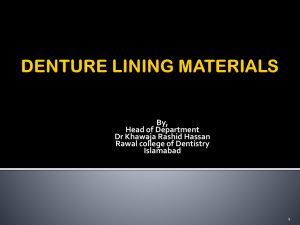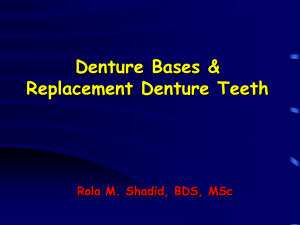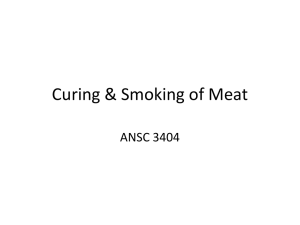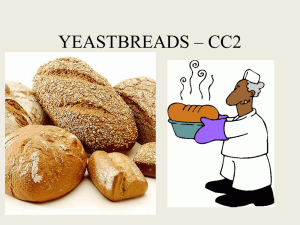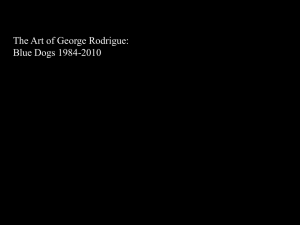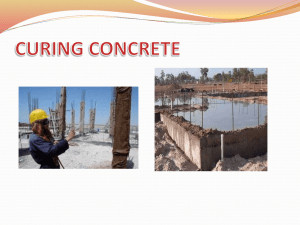DENTURE BASE POLYMERS
advertisement
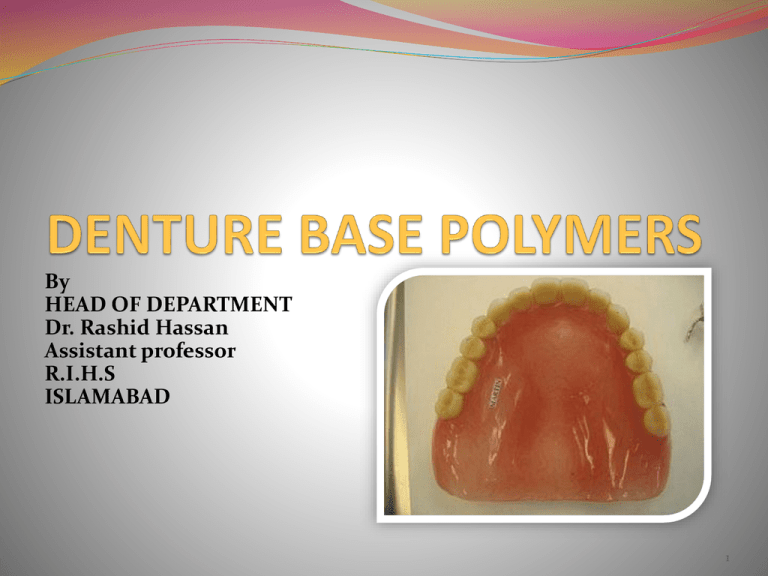
By HEAD OF DEPARTMENT Dr. Rashid Hassan Assistant professor R.I.H.S ISLAMABAD 1 DENTURE BASE MATERIALS Denture base materials can be divided into two types. 1. METALLIC DENTURE BASE: Gold alloys, cobalt chromium alloys. 2. POLYMERIC DENTURE BASE: Acrylic polymers. 2 DENTURE BASE MATERIALS Denture base is that part of the denture that rests on the soft tissues and does not include the artificial teeth. Before 1940, vulcanite/Nitrocellulose/phenolformaldehyde/Vinyl plastics and Porcelain were used as denture base materials. 3 DENTURE BASE MATERIALS Acrylic was introduced as D.B.M in 1937. Other polymers developed by that time included Vinyl acrylic/Vinyl styrene/ Polystyrene/ Epoxy/ Nylon/ Polycarbonate/ Polyurethane/ Light activated polyurethane and Rubber reinforced acrylics. Nowadays acrylic resin is used universally as a denture base. 4 ACRYLIC DENTURE BASE Acrylic denture base is fabricated in a 2 parts gypsum mould. Mould is produced by investing wax trail dentures on which artificial teeth are mounted. Wax is boiled out. Gypsum mould is treated with a separating media. The space left in the gypsum mould after boiling out the wax is filled with acrylic dough. The acrylic dough is either heat cured or self cured. 5 REQUIREMENTS OF DENTURE BASE POLYMERS 1. PHYSICAL REQUIEMENTS: 2. CHEMICAL REQUIREMENTS: 3. BIOLOGICAL REQUIREMENTS: 4. MECHANICAL REQUIREMENTS: 5. OTHERS: 6 REQUIREMENTS OF DENTURE BASE POLYMERS PHYSICAL REQUIREMENTS: Matching natural appearance. High glass transition temperature. Good dimensional stability. Low specific gravity. High thermal conductivity. Should be radiopaque. 7 REQUIREMENTS OF DENTURE BASE POLYMERS CHEMICAL REQUIREMENTS: Chemically inert. Should be insoluble in oral fluids. Should not absorb water or saliva. 8 REQUIREMENTS OF DENTURE BASE POLYMERS BIOLOGICAL REQUIREMENTS: In unmixed or uncured state it should not be harmful to the technician. Set denture should not be toxic and irritant to the patient. If degree of absorption occurs, the denture base must not sustain the growth of bacteria and fungi. 9 REQUIREMENTS OF DENTURE BASE POLYMERS MECHANICAL REQUIREMENS: High value of modulus of elasticity. High value of elastic limit. Should have sufficient flexural strength. Base material should have adequate fatigue life. Should have high impact strength. Should be abrasion resistant. 10 REQUIREMENTS OF DENTURE BASE POLYMERS OTHERS: Should be inexpensive. Have a long shelf life. Easy to manipulate. If fractures, should be easily repaired. 11 ACRYLIC DENTURE BASE MATERIALS Most widely used denture Base material. According to I.S.O Denture base polymers are Classified into 5 types. Type 1 & 2 are most widely Used products. TYPE CLASS DESCRIPTION 1 1 Heat processing polymers(powder & liquid) 1 2 Heat processed (plastic cake) 2 1 Auto polymerized polymer (powder & liquid) 2 1 Auto polymerized polymers (powder & liquid, pour type resins) 3 Thermoplastic material. 4 Light activated material. 5 Microwave cured material. 12 COMPOSITION OF TYPE 1 & TYPE 2 MATERIALS Supplied as powder and liquid. POWDER: Polymer polymethyl methacrylate beads. Initiator Benzoyl peroxide. Pigments Salts of iron, cadmium or organic dyes. LIQUID: Monomer Methylmethacrylate. Cross linking agent Ethylenegylcoldimethacrylate. Inhibitor Hydroquinone. Activator dimethyl-p-toluidine. 13 POLYMETHYL METHACRYLATE Clear, glass like polymer. Manufacturers add opacifiers and pigments in order to produce a more life like denture base. Pink pigments are used mostly. ( salt of cadmium) Pink pigments have good colour stability. 14 METHYL METHACRYLATE Major component of liquid. Clear, colourless, low viscosity liquid. Boiling point is 100.3 °C. On activation by heat or chemical means MMA polymerizes to PMMA. Cross linking agents improve the physical properties. Inhibitor improves the shelf life. Activator is only used in self cure OR auto polymerizing material. 15 HEAT CURING MATERIAL Mixing: Powder and liquid are mixed to form a dough. Powder to liquid ratio is important for workability and dimensional stability. MMA monomer undergoes 21% shrinkage by volume on conversion into polymer. For workable mix and low shrinkage, powder / liquid ratio of 2.5:1 by weight is used. (volumetric shrinkage 5-6%) 16 HEAT CURING MATERIAL STAGES OF MIX: 1. Sandy stage. 2. Stringy stage. 3. Dough stage. Packing should be done in dough stage. If packing is delayed from dough stage the material becomes tough, rubbery and eventually hardens. Transition from sandy to stringy to dough stage is due to physical changes within the mix. 17 HEAT CURING MATERIAL CURING: After filling the mould with dough the next stage is polymerize the monomer. Curing is carried out either in water bath or in an air oven. Different curing cycles are available. Following points must be kept under consideration when choosing an appropriate curing cycle. Cont……. 18 HEAT CURING MATERIAL 1. Benzoyl peroxide initiator forms free radical above 65°C. 2. Polymerization reaction is highly exothermic. 3. Boiling point of monomer is 100.3°C. 4. High degree of monomer to polymer is important to produce a polymer with high molecular weight. 19 HEAT CURING MATERIAL CURING CYCLES: Heat the flask containing dough for 7 hrs at 70°C followed by 3 hrs at 100°C. In another cycle, flask is placed in a bath of cold water, water is gradually allowed to boil over a period of 1 hr and then allowed to cool slowly. Very few manufacturers recommend that the flask containing dough is directly placed into boiling water as it will raise the temperature of the dough to 150°C. 20 HEAT CURING MATERIAL DEFLASKING: Before deflasking the denture the flask is allowed to cool to room temperature. This may lead to setting up of internal stresses within the denture. Internal stresses may lead to warpage. The magnitude of internal stresses can be reduced by allowing the flask to cool slowly from the curing temperature. 21 AUTOPOLYMERIZING MATERIALS Powder and liquid components are mixed together just as for the heat curing product. Viscosity of mixture is increased as the material reaches the dough stage. Smaller acrylic beads gets dissolved in the polymer while larger beads absorb monomer and swell up. Self cure acrylic reaches the dough stage quiet quickly and remains workable for a short period of time. Rate of polymerization increases and the temperature is raised. Use is restricted to repairing and relining the dentures. 22 POURABLE RESINS A type of cold cure resin. Low powder to liquid ratio. Material is poured into a hydrocolloid mould and allowed to cure at or just above room temperature. The advantage is that the cured denture can be removed from the flexible mould with minimum time and effort and denture base require a minimum finishing. High residual monomer and inferior mechanical properties are the main disadvantages. 23 POROSITY 1. GRANULAR POROSITY: Proportioning of powder and liquid is carried our by placing liquid in the clean dry vessel. Powder is added slowly. Mixture is stirred and allowed to stand until it reaches dough stage. Lid of the vessel is closed. Loss of monomer during this stage can cause granular porosity. Giving a blotchy opaque surface, 24 POROSITY 2. CONTRACTION POROSITY: After placing dough in the mould pressure is applied. Use of insufficient dough or the application of less pressure can lead to porosity voids during curing. Voids are dispersed all along the mass of the denture base. This leads to contraction porosity. 25 POROSITY 3. GASEOUS POROSITY: On polymerization there is an exothermic reaction. This causes the temperature of the resin to rise above 100°C. If the temperature increases before the polymerization process is completed gaseous monomer is formed. This causes gaseous porosity. Gaseous porosity can be avoided by rising the temperature in a slow and controlled fashion. 26 PROPERTIES GLASS TRANSITION TEMPERATURE: For heat curing material Tg has a value of 105°C. For cold curing resins Tg is 90°C. The use of water above 65°C for soaking denture must be avoided. SPECIFIC GRAVITY: Low specific gravity (1.2 g/cm³) RADIOLUCENT: Acrylic dentures are made up of C, O and H atoms. (poor X-ray absorbers) 27 PROPERTIES THERMAL CONDUCTIVITY: Thermal conductivity is 100-1000 times less than the values of metals and alloys. Thermal conductivity is very low. FATIGUE FRACTURE: Acrylic denture has a poor resistance to fatigue fracture. IMPACT STRENGTH: Poor impact strength. Crack propagates easily when impact force is applied. 28 PROPERTIES CRAZING: Series of surface cracks which have a weakening effect on the denture base. Causes of crazing: Drying out of denture. Use of porcelain teeth. Denture repair. 29 PROPERTIES ABSORPTION OF WATER: Acrylic resins slowly absorbs water. Water absorption causes dimensional changes which is insignificant. Water absorption causes certain organisms to colonize on the fitting surfaces. Regular cleaning and soaking in water overnight prevents the growth of unwanted organisms. 30 PROPERTIES ACRYLIC ALLERGY : Residual MMA monomer in the base. I.S.O standard for denture base gives upper limit of 2.2% residual monomer for type 1,3,4 and 5 materials and 4.5% for type 2 materials. Residual monomer content depends upon the type of curing cycle used. Polycarbonates and vinyl polymers and vulcanite are used in patients allergic to acrylic. 31 METALLIC DENTURE 32 NON METALLIC/POLYMERIC/ CONVENTIONAL ACRYLIC DENTURE METAL CLASP ARTIFICIAL TEETH ACRYLIC DENTURE BASE METAL LINGUAL BAR 33 MODIFIED ACRYLIC MATERIALS Incorporation of elastomers. Use of acrylic elastomers copolymers. Addition of carbon fibers for fatigue resistance. Incorporation of opacifiers. (one commercially available product contains 8% barium sulphate) 34 QUESTIONS ? 35
